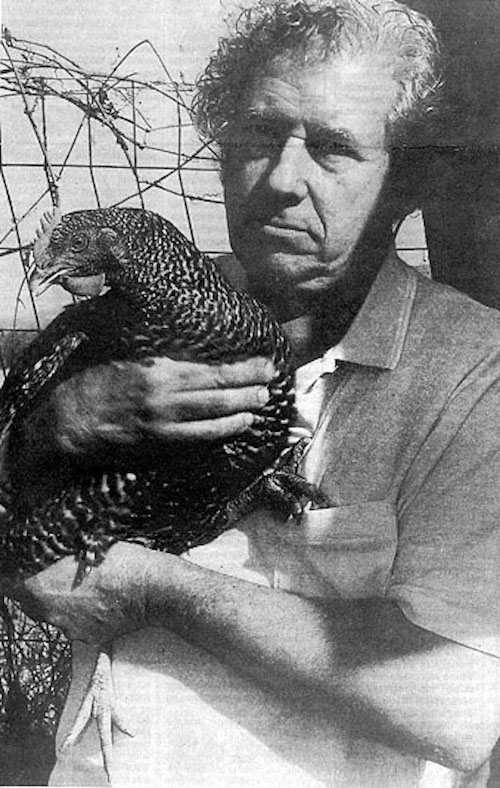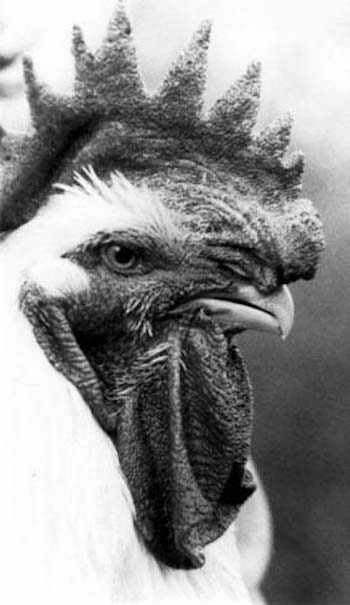Animal Rights/Vegan Activists' Strategies Articles
A Loving Tribute to Henry Spira
From Karen Davis, PhD, President, UPC United Poultry Concerns
May 2022
"I don't think one can
articulate a satisfaction with harming another being whether it's human or
nonhuman."
– Henry Spira
He placed an ad in The Washington Times in 1996 showing a cat going through a meat grinder with the challenge: "Loving and petting one kind of animal while ignoring others who feel exactly the same pain is what's really irrational."

Photo by Nancy Siesel for The New York Times
In the mid-1970s, Henry Spira (1927-1998) questioned getting
involved in the farm animal issue because the issue was just too
big, too "unwinnable." This is the man who went on to become a
vigorous, globally famous advocate on behalf of farmed animals. The
New York Times memorial that appeared on September 15, 1998
explained that Henry, who was born in Belgium and worked in a
manila-folder-stacked New York City apartment where he lived with
his beloved cat Nina, "brought half a lifetime of activism in the
labor and civil rights movements to the animal rights world when he
became involved at the age of 45."
Henry was one of the first great activists for chickens in the
modern animal rights movement, and he was a mentor to me. As part of
our International Respect for Chickens Day/month of May, I am
honored to share with you A LOVING TRIBUTE TO HENRY SPIRA.
**********
In the mid-1970s, Henry Spira questioned getting involved in the
farm animal issue because the issue was just too big, too
"unwinnable." This is the man who went on to become a vigorous,
globally famous advocate on behalf of farmed animals. The New York
Times memorial that appeared on September 15th explained that Henry,
who was born in Belgium and worked in a manila folder stacked New
York City apartment where he lived with his beloved cat Nina,
"brought half a lifetime of activism in the labor and civil rights
movements to the animal rights world when he became involved at the
age of 45."
"'I began to wonder why we cuddle some animals and put a fork in
others,' he often said," The Times article stated. Henry Spira, the
founder and president of Animal Rights International and the
Coalition for Nonviolent Food, was inseparable from my decision to
start United Poultry Concerns in 1990. He was a member of our board
of advisors from the beginning. On October 20, 1989, Henry ran a
full-page ad in The New York Times that showed Frank Perdue with a
Pinocchio nose (for being a liar) with two chicks at the end of it.
It said: "FRANK, ARE YOU TELLING THE TRUTH ABOUT YOUR
CHICKENS? Is Frank Perdue's advertising just a pile of poultry
puffery hiding the brutal realities of an inhumane industry?"
The ad went on tartly to answer these questions.
Henry put the spotlight on chickens, the largest number of abused
warm-blooded animals on earth. He put a face on the poultry industry
by way of Frank Perdue. "The reason for focusing on Perdue is that
the vast majority of factory farmed animals are birds, and because
Frank Perdue has spent hundreds of millions of dollars on ads which
deliberately deceive consumers about the brutal realities of poultry
farming," he wrote. When I was teaching English at the University of
Maryland, Frank Perdue was appointed to the University's Board of
Regents in 1991. Henry joined our campaign to cancel the
appointment. He ran feisty ads in UM student newspapers--
"The P. word. There's a word for someone who does bad stuff for
money. Perdue." He took the train from New York City to UM
campuses to speak at our student rallies against Perdue. Together
with the students, we attended board of regents meetings around the
state where we followed Perdue with our chant, "Cluck You,
Frank Perdue!"
On a Sunday morning in February 1992, Henry took the train to
College Park, and he, I, and two other people drove to Salisbury, Md
where we spent the morning taking pictures inside chicken houses.
That's when we got our "Misery Is Not A Health Food"
photo of a dead chicken in a pile of dead birds on the ground
outside a Perdue house. When I picked up a day-old chick from the
thousands of baby birds at our feet inside a house, I couldn't put
him down. When we got back to College Park, Henry and I sat in my
car looking at this chick, who was at that moment fast asleep. I
said, "This is 'Perdue.'" Henry said, "I know." It was then and
there that he said this bird should be named Phoenix after the
mythical bird who eternally rises from the ashes of death.

Phoenix
I watched Phoenix die of congestive heart failure at our sanctuary
on April 18, 1993, 14 months later. Henry wrote to me:
"Dear Karen, You and Phoenix had a great life together, from the day we found him. You did everything, and more, that could be done to give him as happy and satisfying a life as is possible, within the parameters of his genetic makeup. Certainly Phoenix, true to his name, will live on, not just in our memories but in that, thinking of Phoenix, we will be energized to fight harder for all his brothers and sisters. Love, Henry."
In the video that Henry's mentor, friend and colleague, Peter Singer, did to honor Henry just before he died, Henry Spira: One Man's Way, there's a scene of Henry shouting through a bullhorn – that's our UPC bullhorn in front of the Perdue chicken slaughter plant in Salisbury, Md, May 1, 1992. The occasion was UPC's Second Annual Spring Mourning Vigil for Chickens. Henry came down from New York to be with us. We spent the day surrounded by Perdue trucks stacked with those individuals who represented, in Henry's words, "the largest universe of pain and suffering" in the world.
“May 19th, 1991. Dear Karen, I look forward to your participation at our "Opportunities, Priorities and Strategies for the 90's" round table discussion on Saturday, June 1, 1991 at the NY Academy of Sciences, 2 East 63 Street, in New York City from 9am to 5pm. Peter Singer will be the luncheon speaker. There are several reasons why a meeting along these lines could be productive at this time, among these, indications that there will be an expansion in the movement's agenda for the 90's. . . . It is now inevitable that the movement will expand into the arena of factory farming which accounts for 95% of all animal suffering--an arena with correspondingly far greater challenges. . . .”
• • •
“Animals are not edibles.”
– Henry Spira
Factory-farmed animals and vegetarianism were Henry's focus in the
1990s. His full-page ads in The New York Times showing steers being
branded on the face with red hot irons were decisive in putting an
end to this USDA atrocity in 1994: "THIS IS WHAT USDA POLICY LOOKS
LIKE. CAN YOU IMAGINE WHAT IT FEELS LIKE?" He placed an ad in
The
Washington Times in 1996 showing a cat going through a meat grinder
with the challenge: "Loving and petting one kind of animal while
ignoring others who feel exactly the same pain is what's really
irrational."
The last time I talked with Henry was in July. I knew he had cancer,
but I didn't know he was about to die. I called him to ask if he
would like to donate to our ad in DVM Newsmagazine, urging
veterinarians to oppose the starvation of hens used for egg
production. He said, "Sure." This was Henry, working for animals
until he died. As he said about Phoenix, so it may be said about
him. Henry Spira will live on, not just in our memories but in that,
thinking of him, we will be energized to fight harder for all his
brothers and sisters. This fight was what justified human life for
Henry Spira, and he exemplified his belief.
Return to Animal Rights/Vegan Activist Strategies






